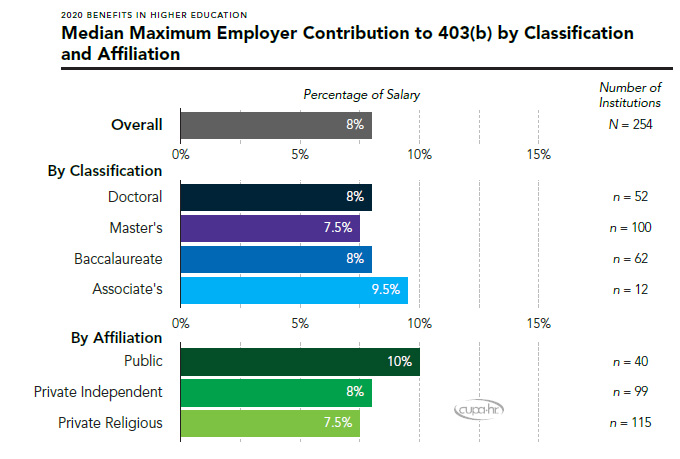New CUPA-HR Report Shows Associate’s Institutions Lead in Retirement Benefits Offerings
According to findings from CUPA-HR’s Benefits in Higher Education Report — Paid Time Off, Tuition Reimbursement, and Retirement, associate’s institutions have some of the most generous retirement benefits in comparison to doctoral, masters or baccalaureate institutions.
The 403(b) plan is the most popular retirement plan for both private institutions (where 92 percent offer it) and public institutions (where 95 percent offer it). The median maximum employer contribution is 8 percent of the employee’s salary, though associate’s institutions have a median employer contribution of 9.5 percent.

Only 4 percent of associate’s institutions charge record-keeping fees. Other classifications are more mixed. Overall, 44 percent of institutions charge record-keeping fees for retirement plans. Among institutions that charge record-keeping fees, private institutions charge higher fees than do public institutions.
Other findings from the CUPA-HR Benefits in Higher Education Annual Report include:
- Only about one-third of institutions surveyed offer paid parental leave beyond vacation and sick time. Since 2018, the number of institutions offering paid parental leave for all types of new parents increased by about 9 percentage points.
- More than half of institutions (57 percent) offer some form of short-term disability leave. Short-term disability leave is more common at private institutions than at public institutions.
- Paid-time-off (PTO) plans that separate sick and vacation leave offer more PTO and higher PTO accrual limits than PTO plans that combine sick and vacation leave.
- Nearly all institutions (98 percent) offer tuition benefits to full-time employees, and most institutions also offer tuition benefits to full-time employees’ spouses (87 percent) and children (91 percent). A smaller percentage of institutions offer these benefits to domestic partners, and these benefits are more commonly provided to same-sex domestic partners than to opposite-sex domestic partners.
A total of 419 institutions completed the survey. Institutions are well represented in this year’s data by classification, affiliation, and region. Because this data was collected with an effective date of January 1, 2020, this report provides the most up-to-date baseline workforce data to gauge the changes that are made to these benefits in the next year as a result of budget cuts due to the COVID-19 pandemic.
CUPA-HR’s survey of benefits for higher education employees has been conducted since 2003. Data is typically collected on healthcare benefits in odd years and on paid time off, tuition reimbursement, and retirement benefits in even years. Because higher ed institutions are facing severe budget cuts in the wake of COVID-19, CUPA-HR will collect data on all benefits for the 2020-21 cycle — including healthcare, paid time off, tuition reimbursement, and retirement benefits — to help institutions make data-based decisions on benefits change.
To learn more about the Benefits in Higher Education Survey, read the overview. Salaries, demographic comparisons and detailed trend information are available in the full report.


